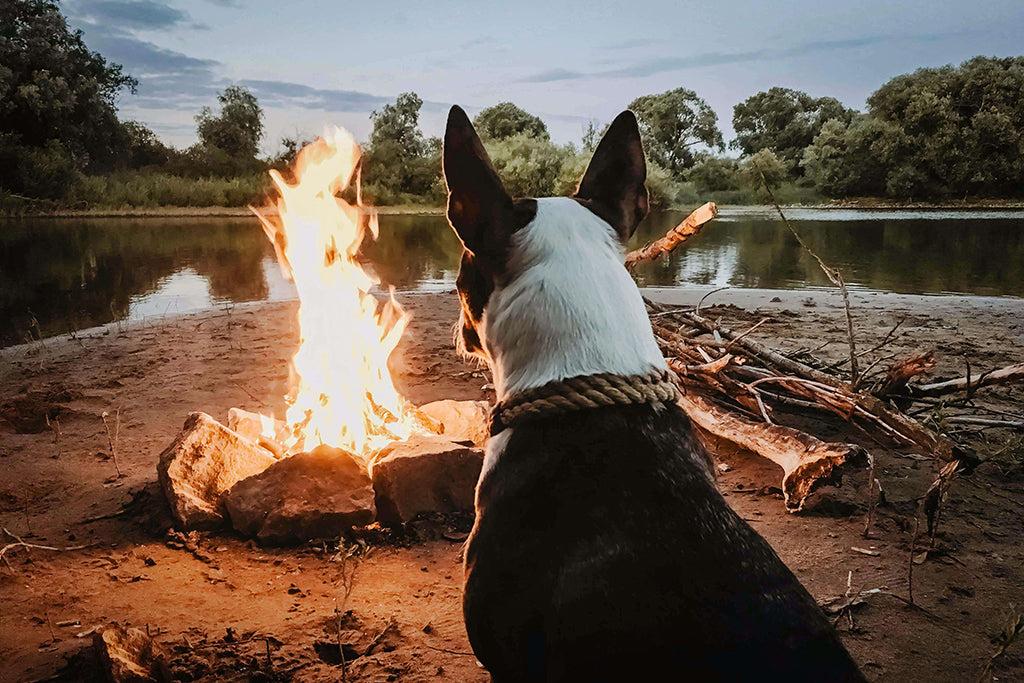In this blog, we learn all about pet fire safety! We’ll find out how we can protect our pets in the case of fire and how to be the best pet parent in one of the worst situations. Read on to find out how to protect your pet in a fire.
How To Protect Your Pet In A Fire

Our dogs, cats, and other domestic animals we may choose to keep are a part of our family. Therefore, if we’ve run fire drills with our partner and kids, we need to consider what we’d do to help our dog out of the house in case of fire too.
Can Dogs Smell Smoke?
There’s no sure-fire way to tell your dog is smelling smoke specifically, but dogs will try and get away from a scent they don’t like as quickly as possible. They can usually tell if something smells bad or is posing a threat to them or their family and will try and do what they can to help.
A dog will typically howl, jump and/or bark to get your’s or someone’s attention that there is a fire or other dangerous issue arising.
If a smell (like smoke) is distressing them but the fire isn’t obvious, they may sneeze, exhibit distressed behavior, pant, and/or face in the direction of the smoke or smell.
If your dog is displaying behavior like this, make sure you don’t punish them or ignore them. Let them take you to where they can smell danger and determine the situation yourself, raising the alarm and evacuating if required.
You could also consider actively training your dog to bark at you in emergencies, rather than just relying on their instincts. Contact an ethical, kind, reputable, professionally qualified trainer to help advise you on how to do so.

How To Prevent Your Pet From Causing A Fire
Yes, your pets are of course capable of starting an accidental fire in your home! Cats jumping onto hobs, knocking over lit candles, or dogs throwing their toys into a fire… Just like child-proofing, you need to pet-proof your home too to protect everyone from a potential fire.
Fireplace Guards
Always cover a fireplace with a guard, and never leave a lit fire unattended when a pet is present.
Secure Wires, Cords, and Cables
Particularly if you own a teething puppy, secure your cords and wires in specially designed cases or bind them properly to the wall so your kitty or pup can’t chew at them or play with them.
Avoid Open Flames
Like to light candles? It may be worth investing in some faux, flameless candles or if you must have real ones, keep them out of reach of wagging tails and curious paws. And, just like with fire, never leave a lit flame unattended. The same rules go for things like BBQs and outdoor grills, pizza ovens, or fire pits.
Oven Protection
You can get covers to put over your dials, knobs, and switches on your oven or stovetop to stop them from being turned unintentionally by stray paws! To stop your pet from trying to get up there in the first place, cover and move leftovers to the fridge as soon as possible and keep flammable items (like oils) in cupboards instead of next to the cooking area.
How To Protect Your Pet In A Fire
You can’t always prevent a fire, but there are several steps you can take to prepare for the case of one and ultimately help preserve your pet’s life:
- Fit smoke and carbon monoxide detectors and check regularly that they work
- Have your pet microchipped and make sure they’re always wearing a collar with ID tags in case they become lost or injured because of a fire
- Consider having a pet door installed so they have easy access in and out of the house
- Don’t lock your pet in anywhere like a cage or a room unattended. If you have to, choose a room that’s closest to the main entry door so a firefighter will be able to get to them
- Know where your pets nap, take a time out or hide because if they can’t be located and are scared or injured, that’s probably where they’ll put themselves. Don’t know where your dog or cat wanders off to sometimes? Follow them. It may save their life one day.
- Practice fire drills as you would at work, school, or at home with your children, with your pet. Get your dog or cat used to being picked up and marched out of the house, so they don’t struggle/panic as much in a real scenario. In particular with dogs, get them really good at their recall training so you know they’ll come to you even when confused in an emergency and away from the danger.
Unfortunately, the reason for most pets dying in house fires is because their owner wasn’t at home and they couldn’t find a way out. So, you may want to consider kitty or doggy daycare or hiring a sitter if you’re away from the home and there can’t be someone you know or another adult member of the household present with them.
PetLab Co. Pro Tip: It may also be worth leaving an emergency pet evacuation pack as close to the main entrance to your home as you can. This can include a spare collar, leash, any medication they need, water, and a portion of food. In case you have to leave your cell behind, you may also choose to put a photograph of your pet in this pack in case you become separated in an emergency and you can show others what they look like.

How Do You Let Firefighters Know You Have Pets?
If you’ve managed to get out of the house quickly but had to leave your furry friend behind due to it being unsafe or impossible, communicate that you have a pet stuck in the house to firefighters as soon as you can.
However, if the worst happens and you’re left unconscious or injured due to fire, you won’t be able to do this. To cover this potential circumstance, you can get a sticker that clearly states the number of pets and the types of pets present in your home that will need the fire rescue’s assistance. You can also put their vet’s contact details on it. Place the sticker in the window as close to the main entrance of the property as possible.
If you are able to leave your home with your pets, make sure you communicate to the fire service that you’ve rescued the pets mentioned on the sticker so they don’t waste their time or risk their lives unnecessarily.
Sources
Author Martin, Molly “Can Dogs Smell Smoke” Wag Walking, May 18. 2018 https://wagwalking.com/sense/can-dogs-smell-smoke
“How To Protect Your Pet In A Fire” Purely Pets Insurance, May 14. 2018 https://www.purelypetsinsurance.co.uk/blogs/how-to-protect-your-pet-in-a-fire/
“Fire Safety and Your Pets: Keeping Them Safe from the Unexpected” ASPCA, Jul 12. 2018 https://www.aspca.org/news/fire-safety-and-your-pets-keeping-them-safe-unexpected
 S
S



